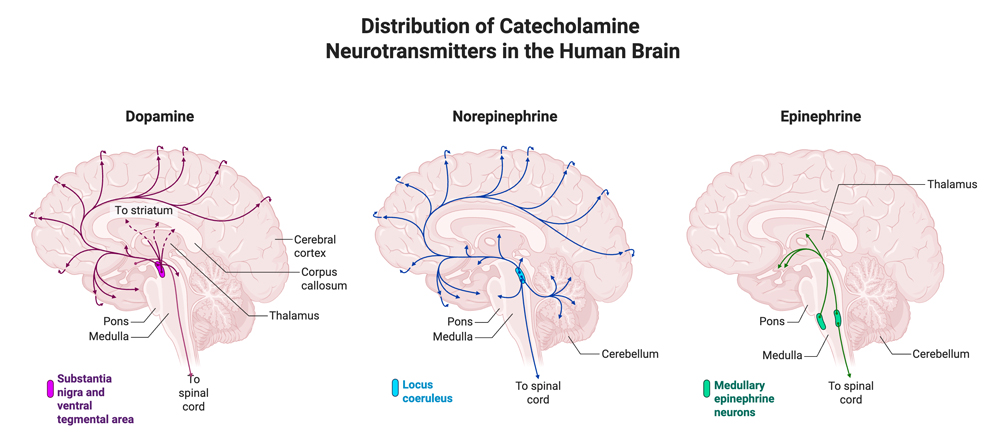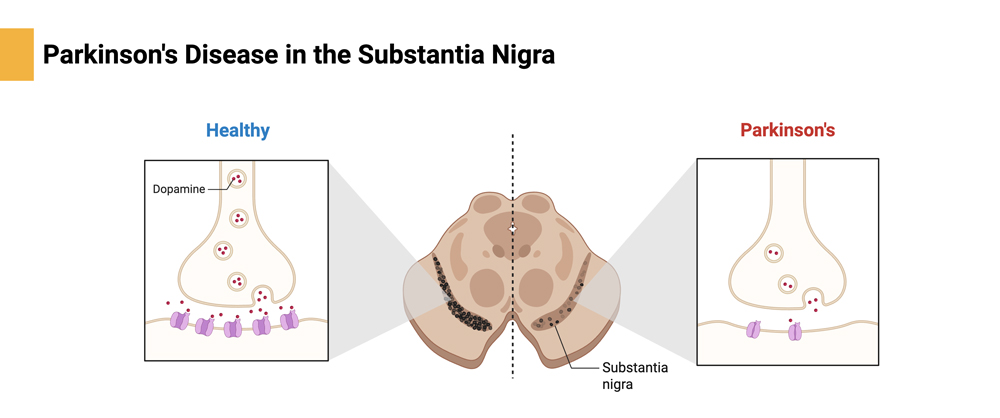 Kauê Machado Costa, Ph.D., in his lab. As soon as he delved into the details of dopamine, he had found his research niche. "It is so important for almost everything the brain does," Costa said. Photo: Andrea Mabry, UAB Marketing and Communications
Kauê Machado Costa, Ph.D., in his lab. As soon as he delved into the details of dopamine, he had found his research niche. "It is so important for almost everything the brain does," Costa said. Photo: Andrea Mabry, UAB Marketing and Communications
You won’t get very far without dopamine.
That is the problem at the heart of Parkinson’s disease; the death of dopamine-producing cells eventually leaves many patients unable to walk.
Too much dopamine, on the other hand, will take you farther than you want to go. The delusions and hallucinations of schizophrenia have long been understood to be caused in part by higher-than-normal levels of dopamine in the brain.
Smaller fluctuations or dopamine-fueled errors lie behind addictions (too much dopamine) and lack of motivation or inability to learn (too little).
Where to start with dopamine? Largely produced in one tiny area of the midbrain, this molecule is chemically related to epinephrine (adrenaline) and norepinephrine, the source of the famous “fight or flight” responses. But dopamine is far more common than its two fellow catecholamines. In fact, it is practically ubiquitous, affecting regions across the brain — initiating movement, providing motivation, acting as a reward, powering learning and calculating the future.

Dopamine calculates surprise
Calculating? The details here are still a subject of debate; but according to an influential hypothesis, dopamine-producing neurons, primarily in the ventral tegmental area, integrate predictions about rewards, presumably from cortical regions, and sensory and motivational signals that tell them if the rewards were received.
Say, for example, you expected $100 for doing some yardwork at your uncle’s house, but he only gave you $25. The dopamine neuron receives your prediction (big reward) and information about the actual reward (way lower than you thought) and compares the two. Since the predicted reward was higher than the real one, dopamine output is reduced. (There is a constant pulse of dopamine release always going on, “in the background” so to speak.)
Cutting off the dopamine flow is consciously unpleasant. It also feeds back into the predicting brain regions and serves to discount similarly optimistic predictions in the future.
On the other hand, if your uncle had given you $200, you would experience an increase in dopamine release itself and your brain would update its future uncle-related predictions. (Also, you would experience more motivation to pick up the phone the next time your uncle calls.)
In the lingo of the field, dopamine-producing cells are measuring a reward prediction error — the difference between the reward that you predict you will receive and what you actually get. By signaling this surprise signal, it tells the brain’s model that something important needs to be learned.
“It is so important for almost everything the brain does”
Just in the past few years, an explosion of knowledge about dopamine has emerged. And these experimental results, surprisingly, match new theories of human learning inspired by recent AI and machine learning advances. At this cutting edge is UAB neuroscientist Kauê Machado Costa, Ph.D., assistant professor in the Department of Psychology in the UAB College of Arts and Sciences. In 2022, Costa was named one of the Allen Institute’s Next Generation Leaders — an advisory panel for early-career neuroscientists (since expanded to include other specialties). The nonprofit institute’s goal is to explore “the mysteries of biology.” And despite the new findings in the field, there are still plenty of mysteries about dopamine to go around.
To illustrate, consider our brief explanation above of the mechanics behind Reward Prediction Error. RPE is the bedrock of theories on dopamine’s role in learning. But, “there is still a lot of debate in the field about where the predictions come from and how dopamine neurons integrate inputs to generate an RPE signal,” Costa said. “For example, prediction-related information does not come only from cortical neurons, but also several sub-cortical regions, including the striatum.”
Costa is a self-described “dopamine aficionado.“ That does not mean he is into skydiving or high-stakes gambling. “Dopamine is known to have an essential role in nearly all cognitive functions, including motor control, motivation and learning,” Costa and his mentor Geoffrey Schoenbaum, Ph.D., wrote in a 2022 paper that provides a comprehensive introduction to the dopamine field. (At the time, Costa was a postdoctoral visiting fellow in Schoenbaum’s lab at the National Institute on Drug Abuse at the NIH.) Costa was originally planning to specialize in evolutionary comparative neuroscience, “but once I started reading more about the dopamine system I became a dopamine aficionado,” Costa said. “It is so important for almost everything the brain does and there is so much we already know about the physiology and anatomy and structure of these dopamine neurons. That lets you make very strong quantitative hypotheses about what may be happening.”
“A thrilling gold rush”
Costa’s lab is focused primarily on learning, using everything from the latest optogenetic techniques to computational modeling. He is pushing the boundaries of dopamine research across scales and layers of abstraction, from millisecond bursts in individual cells, all the way up to generalized behavior and theoretical computational models that can apply across species.
Describing new findings on learning in their 2022 paper, Costa and Schoenbaum are clearly pumped up. “These exciting developments have instigated a thrilling gold rush of new conceptual explanations and computational models of dopamine function, which may soon rival the diversity of dopamine neurons themselves,” they wrote.
“Dopamine has captured the collective imagination,” said Costa, who also has secondary appointments in the School of Engineering’s Department of Electrical and Computer Engineering and the Heersink School of Medicine’s Department of Neurobiology. “People on social media talk about dopamine optimization and how to increase or decrease dopamine for this and that.” Indeed, two of the top Google autocomplete suggestions for “dopamine” this summer were for “Dopamine Land,” a traveling show promising sensory delights, and “dopamine fasts,” which claim to improve focus by cutting out tech distractions.
“The reality is that things are more complicated,” Costa said. “Dopamine is not just doing one type of work. It’s a neuromodulator.”

Parkinson’s disease: Why do cognitive deficits come first?
Just now, Costa is exploring a new facet of dopamine behavior, with an idea so intriguing that it landed him a $200,000 grant from the Parkinson's Foundation in an extremely competitive call for proposals.
“One of the things I was always fascinated by about Parkinson’s is that you only get those typical motor symptoms happening after half the dopamine neurons in the substantia nigra are dead,” Costa said. “So what are the half of the neurons that don’t die actually doing?”
The cells that die first are primarily the lateral dopamine neurons at the sides of the substantia nigra, which project to the dorsolateral striatum, and these are the ones that are thought to focus on motor control. The neurons in the middle of the substantia nigra are wired to another brain region called the dorsomedial striatum. They are thought to be involved primarily in learning and cognition.
Testing the dorsomedial striatum
Tests that focus on the dorsomedial striatum already exist. One widely used tool is the Wisconsin card sorting test. It asks examinees to sort a set of cards marked with different colors, shapes and numbers of objects depicted. Three cards are face up; the examinee turns over a new card and must decide which pile to put it in. It could match by color, shape or number, and the examiner does not reveal the rule in force; instead, all the examinee learns is whether their choice was right or wrong. Most people guess the rule after a few tries. But after 10 correct responses, the examiner changes the rule without telling the participant, who must now learn the new rule. For people with deficits in the dorsomedial striatum, it takes longer to guess the right rule, especially after the rules change. You can play a demo of the Wisconsin card sorting test here.
That brings us to another puzzle, “which is getting a lot of attention lately,” Costa said. “Today we realize that Parkinson’s patients start having cognitive deficits several years before they get the motor symptoms. What I think is happening is that the more medial ones involved in learning shift their role to compensate for those that die. We think that the deficits in cognition you see in early Parkinson’s disease are related to these compensatory dopamine dynamics.”
This hypothesis was “inspired by work I contributed to still in my Ph.D., where we found that medial substantia nigra dopamine neurons project to both the dorsomedial striatum and the dorsolateral striatum,” Costa said. The dorsomedial striatum is highly involved in learning and decision-making, while the dorsolateral striatum is involved in the execution of motor behaviors, especially those that have been learned and practiced over time. “But in the lateral nigra, which is the area that is first to degenerate in Parkinson’s disease, the neurons project almost entirely to the dorsolateral striatum. So, my hypothesis is that, as the lateral nigra neurons start to lose function and die, medial nigra neurons could change their activity to compensate for the loss of those neurons, in particular by changing their mode of firing from something close to an RPE to something closer to an action signal.”
New ways to diagnose Parkinson’s disease?
If Costa’s hypothesis is correct, it could point the way to targeted cognitive tests, tuned to specific learning deficits that might allow clinicians to diagnose Parkinson’s earlier. Earlier diagnosis means earlier intervention, improved quality of life and, potentially, a chance to slow down disease progression.
Many of the recent discoveries about dopamine and learning, including Costa’s findings, come from fiber photometry recordings in rats. First, researchers manipulate the rats’ genes to make neurons produce fluorescent proteins that react to specific neurotransmitters, like dopamine. Then they use tiny fiber optic cables to see exactly what is happening in precise regions of the striatum or other brain regions that receive dopamine inputs while the rats interact with their environment.
With his Parkinson’s Foundation grant, Costa’s lab will use photometry techniques and clever behavioral tasks to capture the brain changes in a rat model of Parkinson’s disease. “What we think is going to happen is that we are going to get more involvement of signals from those neurons from the medial substantia nigra in the dynamics of movement in the early stages of Parkinson’s disease,” Costa said.
One of the beauties of the dopamine system is that “you can ask very deep questions,” Costa said. “What attracted me was the power of the questions that we can ask and the specificity and the amount of information that we can use to answer questions. For example, if I change this one gene, or silence this one region, can I affect this particular parameter in learning? We can make very particular predictions that we can then rule out with experiments.”
Costa and his students “design, build and 3D-print our own behavioral equipment to peer into the brain and teach our rats,” he said. “I also have a really fantastic group of students doing computational work to see what happens in the orbitofrontal cortex in learning.” Computational models can help make sense of the data generated in physical experiments with animal models. And the results of those computational studies can then suggest potential future physical experiments to validate their predictions.
Costa’s lab is expanding: “I am actively recruiting more students — undergrads, graduate students, and maybe a postdoc or two,” he said. Costa also teaches in UAB’s renowned Undergraduate Neuroscience Program. And he is open to cross-campus collaborations. “There has never been a more exciting time to be involved in dopamine research,” Costa said.